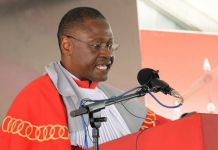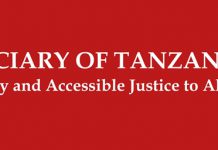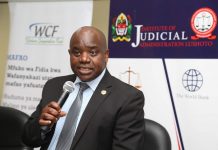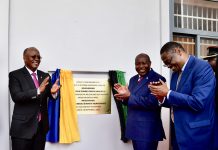THE Judiciary of Tanzania has, during the four years of the fifth phase government, successfully completed 42 projects for the construction and renovation of court buildings at all levels, from primary courts to the High Court.
A statement issued by the Chief Court Administrator, Mr Mathias Kabunduguru, states that the projects have been implemented in various parts of the country with the aim of solving the existing deficiencies and deterioration of court buildings.
He stated that the mission was part of implementation of the government’s intention to improve and move judicial services closer to the people.
As a result of the completion of the projects, the Tanzania Judiciary would officially launch court buildings which would house District Courts in Ruangwa and Kilwa.
Mr Kabunduguru disclosed in the statement that the Ruangwa District court building will be inaugurated on January 14, 2020 by Prime Minister Kassim Majaliwa, while Chief Justice Prof Ibrahim Juma, would launch the Kilwa District Court building on January 15, 2020.
Other completed projects relate to High Court buildings in Kigoma, Musoma, Mbeya and Tanga Regions.
He stated that the Judiciary has undertaken major renovations of High Court buildings in Mbeya and Tanga regions.
According to him, they have built new buildings in Kigoma and Musoma regions and introduced High Court judicial services in those regions.
In addition, he said, the Judiciary has completed the construction of five Resident Magistrate’s Courts in Manyara, Geita, Njombe, Simiyu and Coast regions.
Within the same period of four years, he said, the Judiciary had completed the construction of 16 District Court buildings.
Mr Kabunduguru pointed out that the buildings are at Bagamoyo, Kigamboni, Mkuranga, Ilala, Kibaha, Babati and Bariadi.
Others are in Chato, Geita, Bukombe, Ruangwa, Kilwa Makete, Bariadi, Kondoa, Longido, Chunya and Kasulu.
On the part of primary courts, he stated that the Judiciary constructed modern court buildings at Kawe (Dar es Salaam), Mkunya (Newala), Msanzi (Sumbawanga), Mtowisa (Sumbawanga), Uyole (Mbeya) and Ngerengere (Morogoro).
Furthermore, he said, they completed construction projects for primary courts that were delayed at Iguguno (Singida), Batso (Kondoa), Wasso (Loliondo), Old Korogwe and Magoma (Korogwe), Mvomero (Morogoro), Karatu (Arusha), Robanda (Serengeti), Itinje (Simiyu), Totowe and Mlowo (Songwe).
“The Judiciary is continuing with the construction of Resident Magistrate’s Court buildings in Katavi and Lindi regions as well as district courts at Rungwe, Kilindi, Sikonge, Wang’ing’ombe, Makete and Bunda,” he stated in the statement.
He added that the construction of primary court buildings at Mtae (Tanga), Laela (Sumbawanga), Lugarawa (Ludewa), Mang’ula and Mlimba (Morogoro) was underway.
In terms of renovations, he stated, the Judiciary of Tanzania was undergoing major renovations of High Court building at Sumbawanga Registry.
“All these projects are expected to be completed by June 2020. In addition, we have entered into an agreement with contractors to construct six High Court buildings to be known as Integrated Justice Centres,” the Court’s Chief Administrator pointed out.
Such centres, according to him, would be constructed in Morogoro, Dar es Salaam Region at Kinondoni and Temeke, Dodoma, Mwanza and Arusha.
He explained further that the Judiciary intends to build 33 other court buildings in various parts of the country during the current financial year.
The construction of these buildings, he said, goes hand in hand with the installation of modern ICT systems.
“These achievements are largely attributable to the establishment of the Judiciary Special Fund under the Judiciary Administration Act No. 4 of 2011. This fund facilitates access to development funds and operations of other judicial activities quickly and confidently,” Mr Kabunduguru said.
Despite the past and ongoing improvements over the past five years, he revealed also that the government has issued permits to employ a total of 1414 judicial officers at different cadres, including 430 Magistrates.
From 2016 to date, he said, a total of High Court judges have retired.
He was, however, quick to point out that in order to ensure that delivery of justice services was not affected during the period in question, the Judicial Service Commission advised the President on the appointment of 39 High Court judges, making a total number of in-service judges to 78.
“This was in line under the authority given under Article 113 (1) (a) of the Constitution of the United Republic of Tanzania. The purpose of this increase of staff is to implement the Judiciary’s intention to shorten the period of time of determination of cases,” he said in the statement.
It is stated that cases before the Court of Appeal should not stay pending for more than two years, while at the High Court level, cases should not exceed two years, while at the district and magistrate’s courts cases must be determined within a year and at primary court are to be disposed off with six months.







